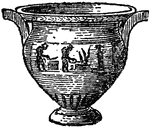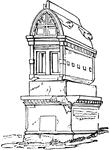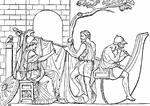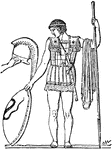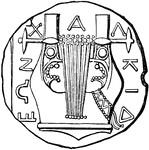
Sphinx
"Sphinx is a Greek word signifying 'strangler,' applied to certain symbolical forms of Egyptian origin,…
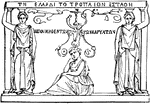
Caryatides
"Caryae was a city in Arcadia, near the Laconian border, the inhabitants of which joined the Persians…
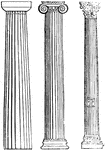
Columna
"A pillar or column. The use of the trunks of trees placed upright for supporting buildings, unquestionably…
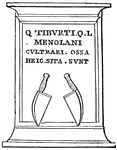
Culter
"A knife with only one edge, which formed a straight line. The blade was pointed, and its back curved.…

Cyathus
"A Greek and Roman liquid measure, containing one-twelfth of the sextarius, or .0825 of a pint English.…

Drachma
"The principal silver coin among the Greeks. The two chief standards in the currencies of the Greek…

Drachma
"The principal silver coin among the Greeks. The two chief standards in the currencies of the Greek…

Fastigium
"An ancient Greek or Roman temple, of rectangular construction, is terminated at its upper extremity…

Greek Chariot
"In the battles, as depicted by Homer, the chiefs are the only important combatants, while the people…

Foot-race
"The Olympic games were of greater efficacy than the Amphictyonic Council in promoting the spirit of…

Wrestling
"The Olympic games were of greater efficacy than the Amphictyonic Council in promoting the spirit of…
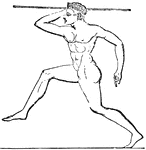
Hurling the javelin
"The Olympic games were of greater efficacy than the Amphictyonic Council in promoting the spirit of…
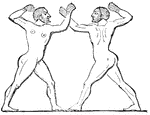
Boxing
"The Olympic games were of greater efficacy than the Amphictyonic Council in promoting the spirit of…

Tripod of Apollo
"It was the universal practice of the Greeks to undertake no matter of importance without first asking…
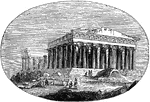
Modern Parthenon
"The Athenians, on their return to Attica, after the defeat of the Persians, found their city ruined…
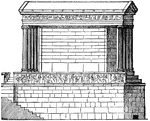
Temple of Nike Apteros
"The first public monuments that arose after the Persian wars were erected under the auspices of Cimon,…
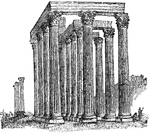
Temple of the Olympian Zeus
"Athens is said to have derrived its name from the prominence given to its worship of Athena by its…

Propylea restored
"A. Pinacotheca, B. Temple of Nike Apteros, C. Pedestal of Agrippa, D. Road leading to the central entrace,…

Parthenon restored
"The Parthenon stood on this highest part of the Acropolis, near its centre, and probably occupied the…

Erechtheum restored
"The building of the new Erechtheum was not commenced till the Parthenon and Propylea were finished,…

Bust of Pericles
"The enormous influence which Pericles exercised for so long a period over an ingenious but fickle people…

Bust of Aspasia
"Pericles, after divorcing a wife with whom he had lived unhappily, took his mistress Aspasia to his…
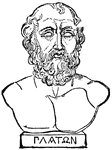
Bust of Plato
"Plato was born in Athens in 429 B.C., the year in which Pericles died. His first literary attempts…
!["Demosthenes had established himself as a public speaker before [the first Phillipic]; but it is chiefly in connection with Phillip that we are to view him as a statesman as well as an orator." — Smith, 1882](https://etc.usf.edu/clipart/16600/16602/demosthnbust_16602_mth.gif)
Bust of Demosthenes
"Demosthenes had established himself as a public speaker before [the first Phillipic]; but it is chiefly…

Coin of Alexander the Great
"Coin of Alexander the Great. Alexander, at the time of his father's death, was in his twentieth year,…

Bust of Homer
"Of the Homeric poems the Iliad and the Odyssey were the most distinguished and have alone come down…
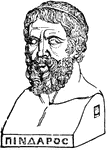
Bust of Pindar
"Pindar, though the contemporary of Simonides, was considerably his junior. He was born either at, or…

Bust of Herodotus
"The first writer who deserves the name of a historian is Herodotus, hence called the Father of History.…

Bust of Thucydides
"Thucydides, the greatest of the Greek historians, was an Athenian, and was born in the year 471 B.C.…
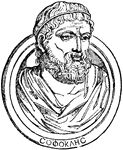
Sophocles
"Sophocles, the younger rival and immediate successor of Aeschylus in the tragic art, was born at Colonus,…
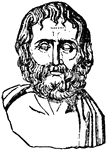
Euripides
"Euripides was born in the island of Salamis, in B.C. 480, his parents having been among those who fled…
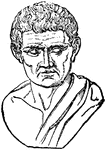
Aristotle
"Aristotle was born in 384 B.C., at Stagira, a seaport town of Chalcidice, whence he is frequeently…

Juno
"The following cut is taken from the Vatican Juno found in the ruins of Lorium." — Anthon, 1891
